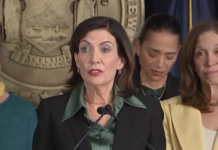A stunning new poll from the Manhattan Institute shows Representative Elise Stefanik (R-NY) narrowly leading Governor Kathy Hochul (D-NY) 43 percent to 42 percent in a potential 2026 gubernatorial matchup. For a state long viewed as safely blue, that’s a political earthquake. The margin is within the poll’s ± 3.3 percent error, technically a tie, but symbolically it marks the first time in decades a Republican has edged ahead in a New York statewide race. Voters seem increasingly restless over high taxes, crime, and affordability — issues that have plagued Hochul’s administration and created an opening for Stefanik’s message of accountability and balance.
The Empire State’s Mood Is Changing
The same voters who gave Republicans unexpected congressional gains in 2022 appear ready to give statewide politics another look. Stefanik’s poll surge echoes Lee Zeldin’s strong 2022 run, when he came closer than any Republican since George Pataki. Many New Yorkers, even moderate Democrats and independents, have grown uneasy with one-party rule that coincides with rising costs, declining safety, and record out-migration. For them, Stefanik’s plainspoken call for common-sense leadership sounds less like partisanship and more like self-preservation.
Stefanik Draws The Battle Lines
During a recent appearance on The Right View with Lara Trump, Stefanik framed the moment as “one opportunity to save New York.” She argued that the city’s hard-left policies and the state’s high-tax environment are driving families out and businesses under. Without naming every opponent, she made clear that her campaign would serve as “a check on radical socialism coming out of New York City,” emphasizing tax relief, safety, and affordability. Her remarks preview a campaign that ties the city’s political drift directly to the state’s economic pain, positioning herself as the balance Albany desperately needs.
The Mamdani Factor: A Tale Of Two New Yorks
While Stefanik builds momentum statewide, New York City is charting a very different course. Assemblyman Zohran Mamdani, the self-described democratic socialist leading the race for mayor, is promising sweeping reforms — rent freezes, higher taxes on businesses, and major spending on social programs. If Mamdani wins City Hall and Stefanik captures the governor’s mansion, New York could become the nation’s most fascinating political standoff: a socialist mayor proposing massive expansion of city government and a Republican governor holding the state’s purse strings.
How A Republican Governor Could Reshape The City’s Agenda
Under state law, New York’s governor wields significant oversight over city budgets, transportation, and education funding. That means a Governor Stefanik could moderate, delay, or redirect policies coming out of a Mamdani administration. State-controlled agencies such as the MTA and the Board of Regents answer to Albany, not City Hall. If the new mayor pushes aggressive tax hikes or city-funded programs that depend on state dollars, a Republican governor could insist on fiscal discipline and accountability before releasing funds. That tension alone could reshape how New York City governs itself.
The Political Optics Of A Split Government
For decades, New York City has set the cultural tone for the state. But with upstate and suburban counties moving rightward, Stefanik’s rise signals a growing divide between city and state voters. Mamdani’s platform may thrill progressive activists, yet statewide polling suggests most New Yorkers prioritize affordability, safety, and jobs over ideology. A Republican governor could use that contrast to her advantage, spotlighting the difference between what voters want and what City Hall proposes. It’s a rare moment when New York’s political geography might favor the right.
The Stakes For Both Sides
For Stefanik, maintaining her lead means building a coalition beyond traditional Republican strongholds — suburban families, small-business owners, and independents tired of endless taxes and soft-on-crime policies. For Mamdani, it means proving his brand of democratic socialism can deliver results without alienating moderates or triggering state intervention. Their agendas cannot coexist easily, which makes 2026 more than just another election year; it’s a contest over who defines New York’s future.
The Bottom Line
The headline “Stefanik Leads Hochul” tells only part of the story. Beneath it lies a deeper realignment — voters rethinking what leadership should look like in a state that’s long been governed from the left. If Stefanik’s edge holds and she moves into the governor’s mansion, New York City’s new socialist leadership would face an immediate check from Albany. It would mark the first genuine ideological balance in decades and test whether New Yorkers truly want reform or revolution. Either way, the Empire State is about to get interesting.
Editor’s Note: This article reflects the opinion of the author.
WE’D LOVE TO HEAR YOUR THOUGHTS! PLEASE COMMENT BELOW.
JIMMY
We welcome open discussion and thoughtful opinions — even strong disagreements — but comments containing profanity, personal attacks, or hate speech will be removed. Keep it civil, keep it smart, and keep it focused on the ideas.
h/t: Steadfast and Loyal



![Watch: Brandon Gill Forces the Truth About White Christian Nationalism [Video]](https://pagetraveler.com/wp-content/uploads/2025/12/brandon-gill-218x150.png)